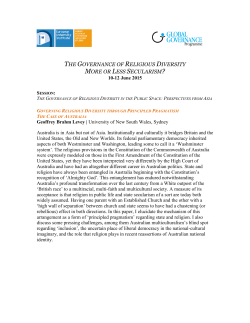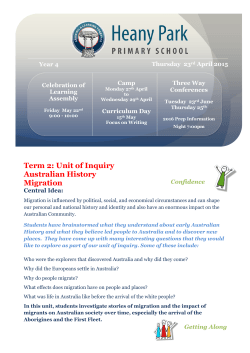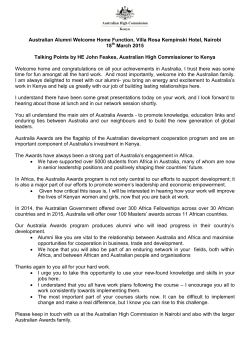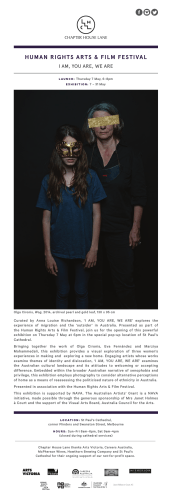
To what extent was Australia cohesive or divided between 1918 and
To what extent was Australia cohesive or divided between 1918 and 1929. Cohesion • White Australia Policy – collective racism • Men, money, markets • Repaying our heroes – intent toward soldiers • Women – less restricted. • International relations • Fear of communism exploited by conservative parties to stay in office. • Social changes – cohesion and division • Domination of conservative parties • Urbanisation • Illusion of cohesion re: Politics • MMM – appeared strong and cohesive – bad / divisive impacts later. • Racism – cohesive force • Desire for British protection • Nationalism / national identity post WW1. • Entertainment • Coalition government • Amongst Aboriginal people • Optimism • Pro-Empire • Modernisation • Roaring Twenties • Distrust of Labor • Fashion Division • • • • • • • • • • • • • Anti-Labor – exploited fear of communism Industrial relations / unrest Politically more divided than cohesive. Migrants Trade unionists versus the government Second half of 1920s = social / economic division Returned soldiers versus workers Soldier Settlement Schemes Racism – Aboriginal Australians, migrants. United whites. Changing values and women Women Aboriginal Australians Conscription debate • • • • • • • • • • • • • Indigenous Australians – alienated from changes of the period. Stolen generations. Actions of government toward trade unions. Pro-republic v British loyalists Those that fought versus those that did not. Economy divided – certain groups excluded, MMM, Racist approach, exclusion of Aboriginal Australians. Conservatives v progressive / Wowsers v progressives ‘Radical Labor’ Labor split 1916 still had effects into 1920s. Class divisions – some not able to enjoy benefits, wages, strikes, govt. did little to help. Working class v upper class – economy = contradictions Religion – protestant v catholic Technological change – most couldn’t afford it. Amplified class divisions. Women – conflicts • • • • • • • • • • • • • • • • • Men, Money, Markets – racist and unfair – led to more problems than it solved. PM Bruce – divided society Coalition government Right wing v left wing Beginning of Great Depression – how to respond? Young v old 1922 elections – division – need for coalition + internal divisions. Physical divisions – rich in suburbs, poor in inner city. Existing divisions widened throughout period. Country Party – represented rural v urban divide Preferential voting Spanish Influenza Traditional Values v new / changing values Hughes v Page v own party – internal division in Nationalist party Government did little to help needy. Bruce-Page government sided with employers Victorian Police strikes Structure: • Introduction: • Key elements of cohesion: • A paragraph on each of two – three key elements. • Key elements of division: • A paragraph on each of two – three key elements. • Conclusion: Structure: • Introduction • Society – cohesion / division • Economics – cohesion /division • Politics – cohesion / division • Conclusion Australian society 1918 - 1929 Australian society in the 1918 – 1929 period is complex to analyse. There were numerous events that give the impression that the period was a cohesive one and that division was limited. For example, there was a shared and cohesive attitude toward repatriating and helping the Diggers following World War One, and that society owed them a debt for their service. There was a growing view too that women’s role in society was changing, and the fight for further autonomy for women was a galvanising one. Australia too experienced the ‘Roaring Twenties’, a period in which many sectors of society were suddenly able to share in the boom in mass entertainment, and people from different sides of the country could share in the same radio programs or movies. Despite these indications of cohesion, Australian society was in fact much more divided than it first appears. Australian society 1918 - 1929 In the 1918 – 1929 period, Australian society was divided for a number of reasons, many of which had their roots in the decades that preceded this period. For example, the conscription debate of World War One was an incredibly divisive issue in Australian society. It exposed and deepened divisions that already existed in society, and opened new ones. These included religious divisions (Irish Catholic v. Protestant British) and class divisions (working class v. upper classes) and more. The divisions associated with the conscription debate continued into 1920s, and were exposed again and again, particularly over the issue of industrial relations. Other clear demonstrations of division in this period are the treatment and experience of Aboriginal Australians, non-British / European migrants and the working classes… Australian economy The Australian economy in the 1918 – 1929 period was also in many ways cohesive. While class divisions based on wealth obviously existed, and the working class continued to agitate for better pay and conditions, the economy itself appeared quite solid in this period. During the 1920s, Australia continued to rely on exports of primary produce, mainly wool and wheat. The Bruce-Page policy of ‘Men, money, markets’ was well supported too, at least initially. It called for increases in immigration, which were to come from Britain, loans from British investors, and the pursuit of overseas markets for Australian products. The idea of assisting migrants from Britain, while socially divisive in some ways, was preferable to an influx of nonBritish / European migrants. So too was the idea of loans for Australian businesses to invest with. In these ways, we can say the Australian economy in this period was reasonably cohesive. However, this does not mean the economy was strong in this period. Australian economy While approaches toward the Australian economy may have been reasonably cohesive, the economy itself had a number of fundamental weaknesses which ultimately led to significant political and economic weaknesses… Australian politics It must be said that Australian politics for most of this period was relatively cohesive. While the period began and ended with significant division, most of the period itself was dominated by conservative governments and parties. This saw a slowing of the progressive reforms that had characterised the early years of the Australian Commonwealth. Many Australians had tired of the division associated with the conscription debate, and mistrusted the Labor party after the split during World War 1. As a result, conservative politicians were able to… Example introductions: Post-war Australia was a time of many things – great optimism and hope as the Nation emerged from war, a sense of national identity and a sense of confidence in the future. For many, this was a time of great growth and social change. For many others, this was simply not the case, and the positives of the time did not reach them. While it can be said that Australia was cohesive for many reasons, it can also be said that it was divisive for just as many reasons, if not more. Australia between 1918-1929 shifted from unity to division. 1918 marked the end of the Great War which had effected Australia significantly. The 1920s was a period for Australians to overcome the war years and enjoy an era of social change and newfound freedom. It was also a period of turmoil, a time with social and economic extremes and conflict. Lives of many were changed by new forms of entertainment, mass production and hopes of a prosperous future. There were others that missed out entirely on the benefits of the age. By 1918 Australia was far less cohesive than it was in the pre-war days, Australian society was deeply divided due to political issues (a later effect of the conscription controversy), frustration over growing imbalance of wages and the cost of living and Aboriginal Australian segregation. However, factors such as the White Australian Policy and technological advancements provided a cohesive force for many Australians. Australia in the 1920s was a time of turmoil which had cohesive and divisive elements to an extent. The ‘Roaring Twenties’ was a time of false prosperity even though some lived with the benefits of the technological developments of the era. After World War One there was a stable government at the helm of Australian politics but there was conflict between old conservative values and ideas and that of the new radical ideas and values due to the revolution of technology. Some elements that were significant in dividing and unifying Australia included the White Australia Policy, the Men, Money, Markets idea and the views of women post World War One. Even though there were cohesive elements to an extent between 1918 and 1929, there were more significant divisive factors during this era. Australia in the 1920s had some cohesive and divisive elements. Australia, as a new nation, had emerged from the war confident and proud. It was a time of relative stability and growth. Politically, the conservative parties and the majority of support for them led to cohesion, but internal division and conservative ideas against progressive ideas led to division. Economically, the ‘men, money, markets’ scheme led to cohesion and industrial unrest led to division. Socially, technology and national pride led to cohesion and conservative views led to division. Overall, Australia was cohesive to a greater extent than it was divisive. Many factors contributed to cohesion and division in Australia during 1918 and 1929. This period in many nations was known as the ‘Roaring Twenties’, a time when industry expanded, Australia was modernised and politics was stable. Those that were not included in the prosperity of the 1920s were left to suffer the conservative and traditional ways of life. Australia was both a cohesive and divided nation. The idea of Australia being prosperous and an egalitarian state contributed to cohesion, however, in reality, divisive elements were visible. Australia during this time can be separated into politics, that is, specifically the Bruce-Page government and their opposition to Labor and Trade Unions, economics, society, including; women, entertainment and the treatement of indigenous Australians and international relations, these factors either were a cohesive or divisive force.
© Copyright 2026









